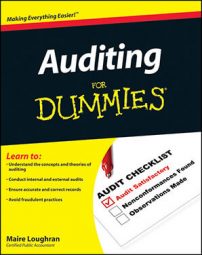When performing an audit, you use risk assessment procedures to assess the risk that material misstatement exists. This step is very important because the whole point of a financial statement audit is finding out if the financial statements are materially correct.
A client’s contribution to audit risk — the risk of a material misstatement existing in the financial records due to errors and fraud — influences your firm’s plans regarding what audit evidence is necessary and which personnel will be assigned to the job. With higher risk comes the need for more involved audit risk procedures.
How exactly do you assess audit risk? You follow various risk assessment procedures: recognizing the nature of the company and management, interviewing employees, performing analytical procedures, observing employees at work, and inspecting company records. After you run through all applicable risk-assessment procedures, you use the results to figure out how high the chance is that your client has material financial-statement mistakes. Not every mistake is important.
Recognizing the nature of the company: Here are some crucial questions to ask the client during your risk assessment procedures:
What’s the company’s market overview? For example, if the client is a bank, in how many states does it operate?
Who (if anyone) regulates the client? Many businesses don’t have an outside regulatory agency, but any publicly traded company is required to file its financial statements with the Securities and Exchange Commission (SEC).
What’s the company’s business strategy? Most business strategies are to maximize shareholder value by increasing profitability and serving the community in which they’re located. The answer may lead you to more probing follow-up questions.
Examining the quality of company management: Inept management that’s lackadaisical about following or enforcing company policies and procedures encourage that attitude throughout the organization. You evaluate management attitude through interviews. Another means is noticing high employee turnover, which can indicate employees are seeking other employment because upper management fails to maintain a quality system of reporting.
If key personnel such as the president, chief financial officer, and chief executive officer have been with the company for many years, that’s usually an indication of quality management. Another good sign is if prior audits have required few, if any, accounting adjustments and there have been no financial statement restatements. Here’s why:
Accounting adjustments are given to the client if a mistake or an aggregate of mistakes is material.
Financial statement restatements are more serious.
Asking employees for information: When asking for information, you should talk to many different employees in the organization besides management. To get a well-rounded idea of the business, talk with individuals holding different levels of authority, from low-level clerks all the way up to the board of directors.
You need to look at problems that can prevent a company from reaching its desired objectives. Each of your client’s functioning departments has different objectives and risks, and understanding them can help you identify potential sources of inadvertent errors or intentional fraud that may affect the financial statements. Here are two real-life examples to consider:
A payroll department objective is the accurate and timely processing of employee payroll payments. A risk associated with this objective is issuing inaccurate payroll payments.
A tax department objective is to meet all legal and regulatory tax return filing obligations. Risks associated with this objective include filing returns that aren’t materially correct and missing the filing deadline.
Analyzing processes and paperwork: Put simply, analytical procedures test to see if plausible and expected relationships exist in both financial and nonfinancial data.
Here are three common analytical procedures you do while assessing audit risk:
Trend analysis: You compare current financial figures to the same figures in the prior year.
Ratio analysis: Some common ratios are the current ratio, and inventory turnover.
Reasonableness: Does what you’re seeing make sense based on other facts? For example, does the depreciation expense appear accurate when you consider the book value of all fixed assets on the balance sheet?
Observing the client at work: One common type of observation is to watch the staff take a count of physical inventory. Visiting the company’s business locations is another. Doing so gives you the opportunity to view the company’s operations beyond what’s in the books and records and to find out about the company’s internal controls.

